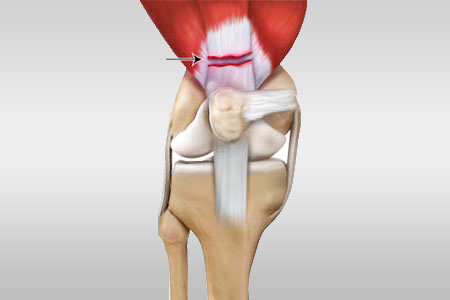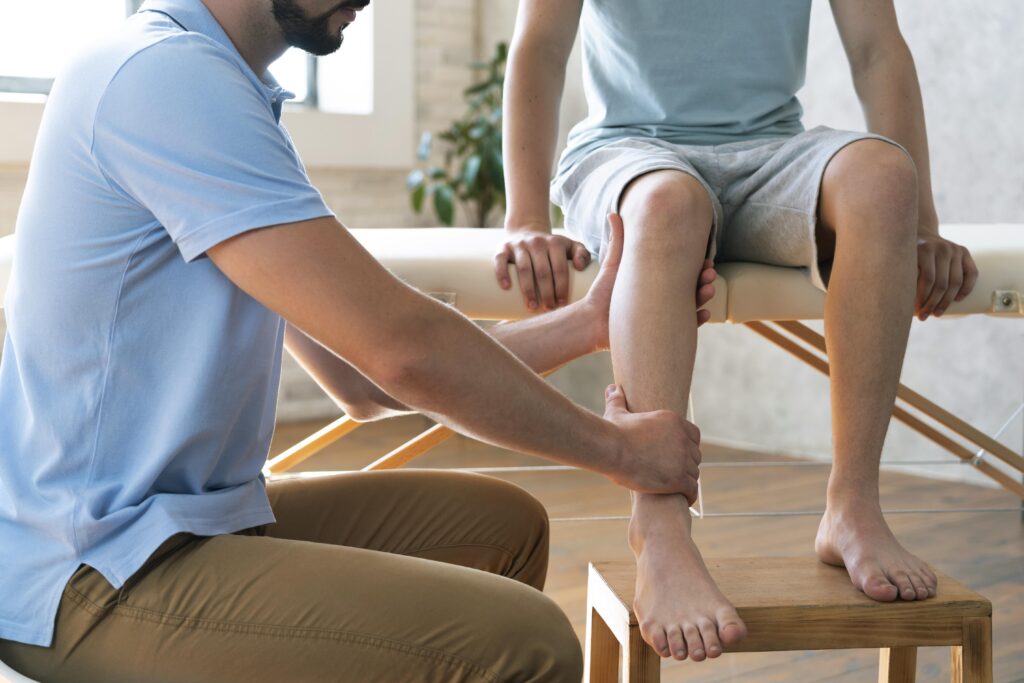Quadriceps Tendon Repair

Understanding
Quadriceps Tendon Repair in Dubai
A path to restored strength & mobility
A quadriceps tendon rupture can be debilitating, making it difficult to walk, straighten the knee, or perform even simple daily activities.
Whether caused by sports injuries, falls, or sudden strain, this condition requires timely medical care. Quadriceps tendon repair in Dubai offers an effective solution to restore knee strength, stability, and function.
At Tarabichi Joint Care, we specialize in advanced quadriceps tendon rupture treatment to help patients return to an active, pain-free lifestyle with expert care and personalized rehabilitation plans.
Quadriceps tendon repair is a surgical procedure that reattaches a torn tendon to the top of the kneecap (patella).
This surgery is usually recommended when the tendon is completely ruptured or when conservative treatments such as rest, bracing, or physiotherapy fail to provide adequate recovery.
The goal of the procedure is to restore the knee’s ability to extend properly, ensuring patients regain mobility and independence.
Anatomy of the Quadriceps
The four quadriceps muscles come together just above the kneecap to form the quadriceps tendon, which connects the muscles to the patella.
From there, the patella is linked to the shinbone (tibia) through the patellar tendon. Together, the quadriceps muscles, quadriceps and patellar tendon function as a pulley system that allows the knee to straighten efficiently.
Symptoms of Quadriceps Tendon Rupture
When a quadriceps tendon rupture occurs, there is often a tearing or popping sensation. Pain and swelling typically follow, and you may find it difficult or impossible to straighten your knee.
Other common symptoms include:
- A visible gap or indentation above the kneecap where the tendon has torn
- Bruising and tenderness around the knee
- Muscle cramping
- A sagging or drooping kneecap due to loss of support
- Trouble walking, with the knee buckling or giving way
Causes of the quadriceps tendon tear
A quadriceps tendon tear usually occurs when the tendon is overstretched or subjected to sudden force. Common causes include:
- Direct trauma – falls, accidents, or a direct blow to the knee
- Forceful movements – jumping, landing, or heavy lifting
- Degenerative changes – age-related tendon weakening
- Medical conditions – diabetes, kidney disease, rheumatoid arthritis, or chronic quadriceps tendonitis
- Medications – long-term corticosteroid or certain antibiotic use
A combination of these factors often makes the quadriceps tendon vulnerable, especially in active, older individuals or those with underlying health conditions.
Diagnosing quadriceps tendon repair
To confirm a quadriceps tendon tear, your doctor will begin with a physical examination, checking your ability to straighten the knee, assessing swelling and tenderness, and looking for a gap above the kneecap.
In addition, imaging tests may be recommended to evaluate the severity of the injury:
- X-rays – To check the position of the kneecap and rule out fractures.
- Ultrasound – To visualize the tendon in real time and detect partial or complete tears.
- MRI scan – Provides detailed images of the tendon and surrounding structures, helping to guide treatment decisions.
Accurate diagnosis is essential to determine whether conservative treatment or surgical repair is the best option.
When is the Quadriceps Tendon Repair Recommended?
Surgery is recommended when:
- Inability to straighten the knee or lift the leg
- A visible gap above the kneecap
- Persistent pain and swelling despite non-surgical care
- A drooping or sagging kneecap
- Difficulty walking due to the knee giving way
Early quadriceps tendon repair in Dubai leads to better healing, restored strength, and improved knee function.
Candidates Eligible for Quadriceps Tendon Repair Surgery
You may be a suitable candidate for quadriceps tendon repair if you have:
- A complete quadriceps tendon rupture, causing the inability to straighten the knee
- A partial tear that has not improved with rest, physiotherapy, or bracing
- A visible gap or drooping kneecap indicates tendon disruption
- Significant weakness, pain, or difficulty walking due to the injury
- Good overall health is required to undergo surgery and rehabilitation
The benefits of quadriceps tendon repair in Dubai
Undergoing quadriceps tendon repair can significantly improve both mobility and quality of life. Key benefits include:
- Restored knee function – Enables you to straighten the leg and regain normal knee movement.
- Pain Relief – Reduces or eliminates pain caused by the torn tendon.
- Improved strength and stability – Rebuilds quadriceps power and helps the knee feel strong and steady.
- Better mobility – Allows you to walk, climb stairs, and easily perform daily activities.
- Return to sports and activity – With proper recovery, many patients return to physical activities, exercise, or sports they once enjoyed.
- Prevention of long-term issues – Early repair reduces the risk of chronic weakness, instability, and joint problems later in life.

Treatment Options for Quadriceps Tendon Repair in Dubai
Non-surgical options
Non-surgical care may be recommended for partial quadriceps tendon tears or in patients who are unsuitable for surgery.
Common approaches include:
- Immobilization – Using a knee immobilizer or cast to keep the leg straight, allowing the tendon to heal naturally.
- Bracing – A supportive knee brace helps stabilize the joint while limiting movement during healing.
- Physical therapy – Guided therapy restores mobility, improves flexibility, and gradually rebuilds quadriceps strength.
- Exercises – Specific strengthening and stretching exercises are introduced as healing progresses to support recovery and prevent re-injury.
Surgical treatment
Surgery is usually recommended for complete quadriceps tendon tears or partial tears that fail to improve with non-surgical care. The goal is to reattach the tendon securely to the kneecap and restore normal knee function.
Common surgical approaches include:
- Open repair – A traditional approach where the surgeon makes an incision over the knee, identifies the torn tendon, and reattaches it to the patella using strong sutures or anchors.
- Reinforced repair – In cases of chronic or large tears, grafts may strengthen the tendon repair and support long-term healing.
- Open cryoablation technique – An advanced method with targeted freezing technology applied during open surgery to reduce pain signals and inflammation around the tendon repair site. This technique may help improve post-operative pain management and recovery outcomes.
Deciding to Get Quadriceps Tendon Repair in Dubai
Quadriceps tendon repair is key to regaining knee strength, stability, and mobility.
At Tarabichi Joint Care Center, our skilled orthopedic surgeons use advanced techniques and personalized rehabilitation programs to help you recover effectively and return to an active lifestyle. A consultation with our team will clearly assess your condition and the most suitable treatment plan.
Book your consultation at Tarabichi Joint Care today and take the first step toward restoring your mobility and living pain-free.
FAQs
Possible risks include infection, stiffness, weakness, blood clots, or re-rupture. These are rare when surgery and rehabilitation are done correctly.
Recovery involves initial immobilization with a brace, followed by physiotherapy. Most patients regain normal mobility in 4–6 months, with sports or heavy activities taking longer.
Preparation may include medical tests, adjusting medications, stopping smoking, and arranging home support for recovery. Strengthening surrounding muscles beforehand may also help.
